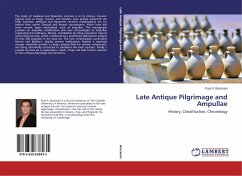The study of medieval and Byzantine ceramics is in its infancy. Ceramic experts such as Hayes, Vroom, and Sanders have greatly advanced the field; however, medieval and Byzantine ceramics investigations are far behind their earlier Classical and Roman counterparts, which have left some ceramic types unclassified, such as ampullae. The monograph provides an ampullae classification and new chronologies to ampullae originating from Ephesus, Monza, and Bobbio by citing excavation reports and primary sources, which is followed by a preliminary distribution analysis of circa 200 ampullae in the data set. The new chronologies, particularly Monza and Bobbio s, display greater implications beyond a typology change. Ampullae provide a unique playing field for ceramic comparison, not being intrinsically connected to commerce like most ceramics. Finally, I provide my data set in appendices, which I hope will help further research on late antique pilgrimage and souvenirs.
Bitte wählen Sie Ihr Anliegen aus.
Rechnungen
Retourenschein anfordern
Bestellstatus
Storno









